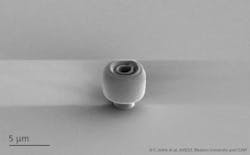Scientists at the research institute AMOLF (Amsterdam, Netherlands) have developed and fabricated a 3D nanophotonic lens in collaboration with the Western University (London, ON, Canada) and the City University of New York.1
Using a Photonic Professional microfabrication system from Nanoscribe (Eggenstein, Germany), the researchers printed an extremely small lens on top of a gallium arsenide nanowire, which is only 80 nm thick and acts as a light emitter. This way, the combination of nanolens and nanowire enables focused light emission, compared to an almost uniform emission of the nanowire itself.
Highly direction-sensitive nanoscale emitters and sensors offer potential in many fields of application. This is the case for optical quantum computers, as well as for solar cells with nanoscale structured areas or surfaces. However, the enhancement of directivity on nanoscale devices is a major technical challenge.
In this work, researchers applied an evolutionary algorithm to design a complex 3D geometry with subwavelength features down to nearly 200 nm. The 3D design uses nanoscale interference effects to achieve a high directivity. The lens has a calculated directivity of 101 for a point source, and 67 for the finite-source nanowire emitter. Directivity is defined as the light emission at one angle relative to the mean light emission over all angles.
Measured directivity was 22, with a half-angle of 3.5°; this number could be boosted more towards its theoretical value with better alignment of the lens to the nanowire, say the scientists.
REFERENCE:
1. Eric Johlin et al., Nature Communications (2018); doi: 10.1038/s41467-018-07104-1.
About the Author
John Wallace
Senior Technical Editor (1998-2022)
John Wallace was with Laser Focus World for nearly 25 years, retiring in late June 2022. He obtained a bachelor's degree in mechanical engineering and physics at Rutgers University and a master's in optical engineering at the University of Rochester. Before becoming an editor, John worked as an engineer at RCA, Exxon, Eastman Kodak, and GCA Corporation.

